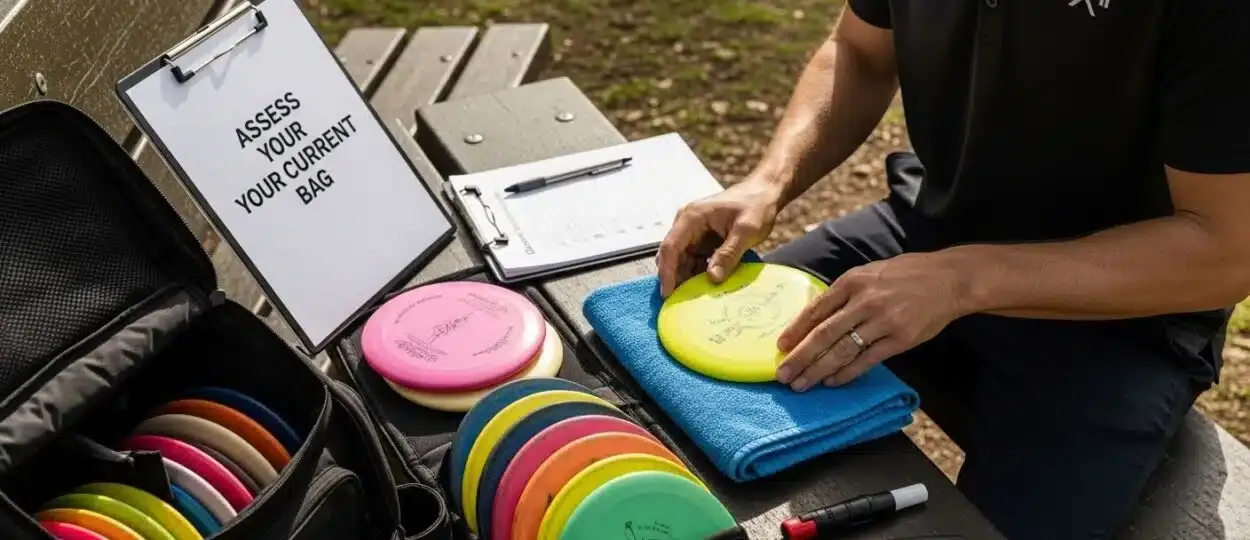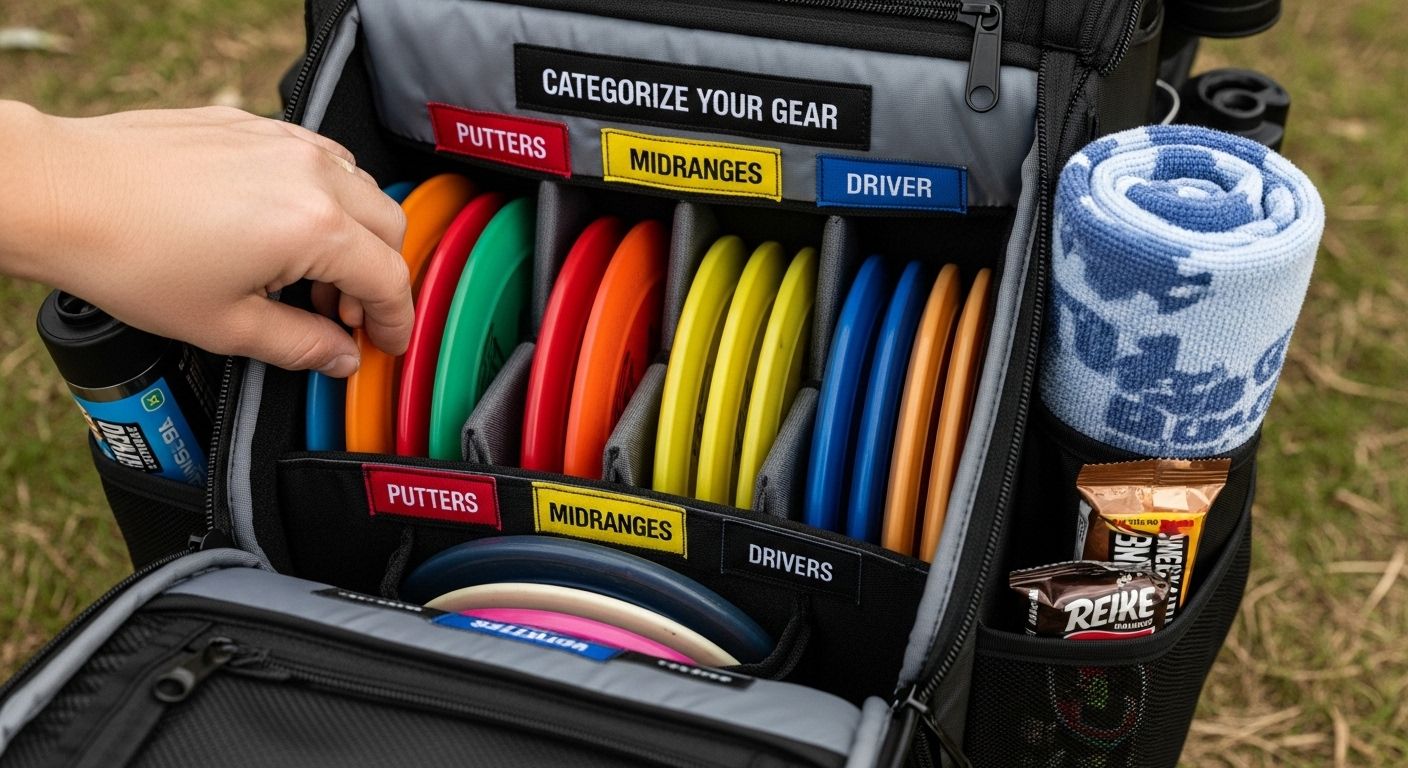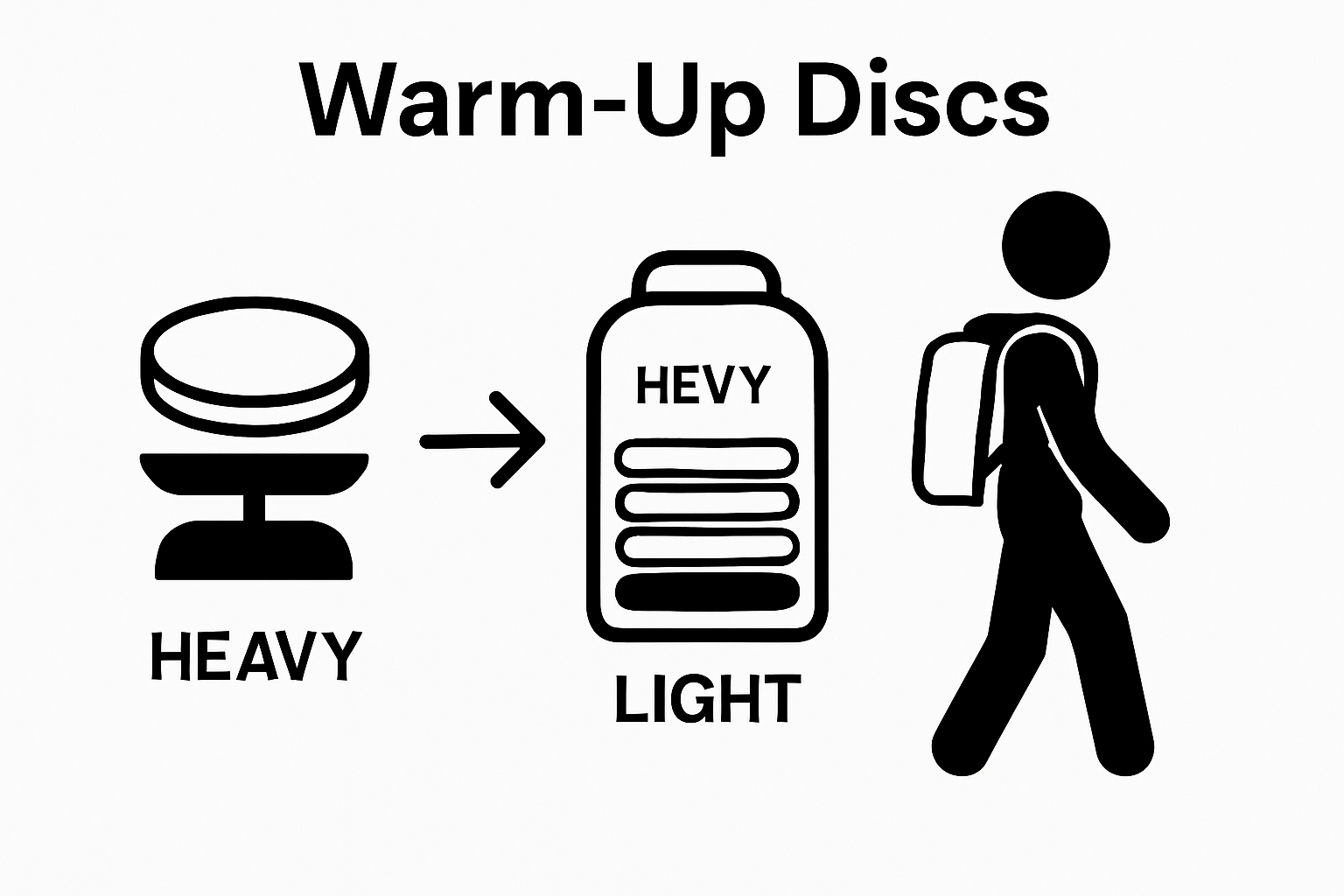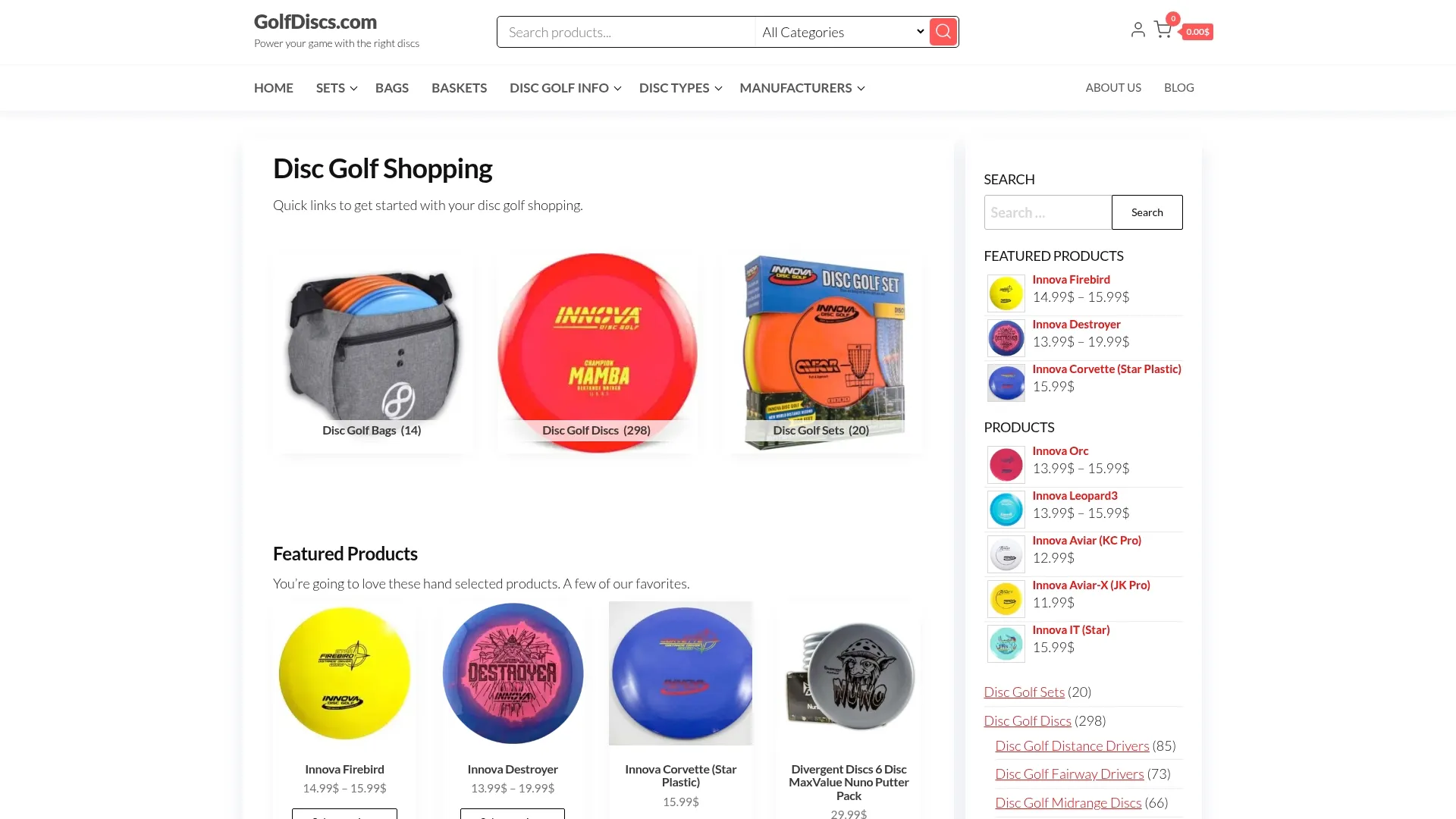
How to Organize Your Bag for Disc Golf Success in 2025
Organizing your disc golf bag can feel overwhelming with so many discs and accessories to keep track of. Most people think tossing everything in and hoping for the best will work. But studies show that a strategic system can actually improve your performance and help you grab the right disc faster every time. That means a simple change in how you pack your bag could be the shortcut to your next best round.
Table of Contents
- Step 1: Assess Your Current Bag Contents
- Step 2: Categorize Your Gear and Essentials
- Step 3: Design a Layout for Easy Access
- Step 4: Pack Efficiently by Weight Distribution
- Step 5: Verify Organization and Make Adjustments
Quick Summary
| Key Point | Explanation |
|---|---|
| 1. Assess Your Current Discs | Empty and evaluate your bag to identify what discs you have, their condition, and any that need replacement. |
| 2. Categorize Discs by Type | Organize discs into putters, midrange, and drivers, further categorized by stability to facilitate quick access. |
| 3. Optimize Bag Layout for Access | Position frequently used discs in accessible areas and use a vertical stacking method for easier identification. |
| 4. Balance Weight Distribution | Place heavier discs at the bottom and center of the bag to reduce strain and improve balance during play. |
| 5. Continuously Test and Adjust | Regularly evaluate your bag’s organization during practice rounds and make adjustments as necessary for optimal performance. |
Step 1: Assess Your Current Bag Contents
Preparing for disc golf success starts with a thorough evaluation of your current disc golf bag and its contents. This crucial first step helps you understand what equipment you already have and identify potential gaps in your gear. The Professional Disc Golf Association recommends a systematic approach to organizing your disc collection, which begins with a comprehensive inventory.
Start by emptying your entire disc golf bag and laying out every disc, accessory, and piece of equipment on a clean, flat surface. Take time to examine each disc carefully, noting its type, condition, and how frequently you use it. Pay special attention to wear patterns, as these can indicate which discs are your go-to tools and which might need replacement. Look for signs of excessive wear like deep scratches, warped edges, or significant discoloration that might affect a disc’s flight characteristics.
As you sort through your collection, create three distinct categories for your discs: frequently used, occasional use, and probably time to retire. This sorting process helps you understand your current disc arsenal and identifies potential gaps in your disc selection. Putter discs, midrange discs, and drivers should each be evaluated separately. Consider the specific flight characteristics of each disc and how they complement your playing style.
Take note of the total number of discs you currently own and their specific types. A well-rounded disc golf bag typically includes a mix of putters, midrange discs, and drivers of various stability levels. If you find your collection is limited in variety, this assessment becomes an opportunity to plan future disc acquisitions that will expand your playing capabilities.
Finally, clean each disc thoroughly with a soft cloth and inspect them for any damage that might impact performance. This cleaning process not only maintains your equipment but also gives you a chance to closely examine each disc’s condition. By the end of this assessment, you’ll have a clear understanding of your current disc golf bag’s strengths and limitations, setting the stage for strategic improvements in your equipment collection.
Step 2: Categorize Your Gear and Essentials
After completing your initial bag assessment, the next critical step is to develop a systematic approach to categorizing your disc golf gear. Research on sports equipment organization demonstrates that strategic categorization can significantly improve performance and preparation. Your goal is to create a logical, easily navigable system that allows quick access to the right disc for every potential shot.
Begin by dividing your discs into primary performance categories: putters, midrange discs, and drivers. Within each category, further subdivide based on stability characteristics such as understable, stable, and overstable. This nuanced organization helps you quickly identify the perfect disc for specific course challenges. Putters should be grouped separately and easily accessible, as they are crucial for short-range precision shots and final putting attempts.
Consider creating a dedicated section in your bag for essential accessories beyond discs. This might include a small towel for wiping discs, spare tees, a mini marker disc, water bottle, and any personal items like sunscreen or energy snacks. Organize these items in easily reachable compartments to minimize disruption during gameplay.
Place frequently used accessories in external pockets or top compartments for immediate access.
Implement a color-coding or labeling system to enhance your organizational strategy. Some disc golfers use colored tape or permanent markers to quickly identify disc types and stability ranges. This visual method allows for rapid disc selection, especially in high-pressure tournament situations or challenging course environments. Think of your bag as a mobile toolkit where every item has a specific, predetermined location.
As a final verification step, test your new categorization system during a practice round. Observe how quickly you can locate and select appropriate discs. A well-organized bag should feel intuitive, allowing you to focus on your throw technique rather than searching for the right disc.
 If you find yourself struggling to find items or feeling disoriented, take time to refine your organizational approach. Remember, the perfect disc golf bag organization is a personal system that evolves with your skills and playing style.
If you find yourself struggling to find items or feeling disoriented, take time to refine your organizational approach. Remember, the perfect disc golf bag organization is a personal system that evolves with your skills and playing style.
Step 3: Design a Layout for Easy Access
Creating an efficient layout for your disc golf bag transforms your equipment from a random collection into a strategic toolkit. According to research on backpack organization, a well-designed storage system can dramatically improve accessibility and performance. Your goal is to develop a layout that allows rapid disc selection without disrupting your game flow.
Place your most frequently used discs in the most accessible locations. Typically, this means positioning putters in the main compartment or an easily reached side pocket. Midrange discs should be next, followed by drivers in slightly less prominent positions. Consider the physical mechanics of how you typically access your bag during a game – the layout should minimize unnecessary movement and provide intuitive disc retrieval.
Implement a vertical stacking method that allows you to see disc edges when the bag is open. This approach prevents disc damage and enables quick visual identification. Some players use soft dividers or create slight angle variations to ensure each disc is partially visible. The key is creating a system where you can quickly scan and select the right disc without extensive rummaging.
Design your bag’s external pockets with intentionality. Smaller compartments are perfect for accessories like towels, spare tees, and mini markers. Consider dedicating specific pockets to specific functions: one for hydration, another for personal items like sunscreen or energy snacks, and a separate area for repair tools or extra accessories. Consistency is crucial – always return items to their designated spots to maintain your organizational system.
Remember that your bag’s layout is a personal system that will evolve with your playing style. Periodically reassess your organization during practice rounds, making subtle adjustments based on how you actually use your equipment. A truly effective disc golf bag layout feels like a natural extension of your playing technique, allowing you to focus on your throws rather than fumbling with gear. The ultimate test is whether you can confidently select the right disc without breaking your game’s rhythm or concentration.
Step 4: Pack Efficiently by Weight Distribution
Weight distribution in your disc golf bag is more than a technical detail – it’s a strategic element that can significantly impact your performance and comfort during play. Engineering principles in sports equipment emphasize how proper weight placement can optimize energy transfer and reduce physical strain.
Start by understanding the weight characteristics of your discs. Putters are typically the lightest, while drivers tend to be heavier. Place heavier discs closer to the center and bottom of your bag to create a stable core. This approach lowers the bag’s center of gravity, reducing strain on your shoulders and improving overall balance during long courses. Imagine your bag as a balanced ecosystem where each disc’s weight contributes to a harmonious whole.
Consider the physical mechanics of how you move while carrying your bag. Distribute weight evenly across both sides to prevent uneven shoulder strain. If your bag has multiple compartments, alternate between heavier and lighter items to maintain a consistent balance. Accessories like water bottles, towels, and snacks should be strategically placed to complement your disc arrangement. A well-balanced bag feels almost like an extension of your body, moving smoothly as you navigate different terrains and execute your throws.
Pay attention to how weight distribution affects your mobility and comfort. During practice rounds, periodically check how the bag feels on your shoulders. Are you experiencing unnecessary tension? Are certain movements becoming more difficult? These are signs that your current packing strategy might need adjustment. Some disc golfers use small weight-balancing techniques like placing a lightweight towel on one side to counteract a slightly heavier disc collection.
The ultimate test of your weight distribution strategy is how you feel after a full round of disc golf. A properly packed bag should feel comfortable, allowing you to focus on your technique rather than fighting against an awkward or heavy load.
 Experiment, make incremental adjustments, and remember that your ideal bag configuration is a personal journey of discovery and refinement.
Experiment, make incremental adjustments, and remember that your ideal bag configuration is a personal journey of discovery and refinement.
Step 5: Verify Organization and Make Adjustments
The final step in organizing your disc golf bag transforms your careful planning into a dynamic, responsive system. Research on athletic performance monitoring emphasizes the critical importance of continuous evaluation and strategic adjustments. Your bag organization is not a static blueprint, but a living system that evolves with your skills and playing style.
Conduct a comprehensive field test during multiple practice rounds to verify your organizational strategy. Pay close attention to how easily you can access discs, the comfort of your bag’s weight distribution, and whether your categorization system feels intuitive. Note any moments of hesitation or frustration when selecting discs – these are clear signals that your current setup needs refinement. Some disc golfers keep a small notebook or use their smartphone to track these observations, creating a systematic approach to bag optimization.
Evaluate your bag’s performance across different course types and weather conditions. A layout that works perfectly on a flat, open course might become challenging on a technical, wooded track. Consider how your disc selection and accessibility change in various environments. Look for patterns in your disc usage – are certain discs consistently overlooked? Are you finding yourself wishing for a different arrangement during critical moments of play?
Remember that bag organization is a personal journey of continuous improvement. What works perfectly for one disc golfer might feel completely counterintuitive for another. Be willing to make incremental adjustments, testing small changes one at a time. Some players find it helpful to photograph their bag’s interior layout periodically, creating a visual record of their organizational evolution. This approach allows you to track your progress and understand how your equipment management has developed alongside your disc golf skills.
The ultimate verification is your comfort and confidence on the course.
Below is a checklist table to help you verify your disc golf bag organization during practice rounds and ensure ongoing optimization.
| Verification Step | What to Check | Recommended Action |
|---|---|---|
| Disc Accessibility | Can you quickly find and select each disc? | Reorganize if access takes too long |
| Bag Weight Balance | Does the bag feel comfortable on both shoulders? | Adjust weight distribution as needed |
| Categorization System Intuitiveness | Is it easy to identify disc types and stability? | Refine categories or labeling approach |
| Essential Accessories Placement | Are towels, snacks, and tools easy to reach? | Rearrange external pocket usage |
| Performance Across Different Courses | Does the system work on various course layouts? | Make location-specific adjustments |
| Response to Weather Conditions | Are discs and gear easily accessible in changing weather? | Repack or shield items as needed |
| Used/Unused Disc Patterns | Are some discs rarely or never used? | Remove or reposition less-used discs |
Ready to Upgrade Your Disc Golf Bag for Peak Performance?
You’ve just explored how proper organization can transform your disc golf game, from assessing your disc selection to designing a smart bag layout. If you feel frustrated by missing the right disc at the wrong moment, or if your equipment just does not match your ambition, now is your chance to take real action. Outdated or insufficient gear can keep you from building the perfect system described in this article, but you do not have to settle for less.

Get everything you need to fill the gaps in your bag and boost your confidence on the course. Shop a wide variety of high-performance discs, accessories, and updated equipment directly at https://golfdiscs.com. Make your disc golf bag support your winning habits. Visit Golf Discs today and step into the 2025 season fully equipped for success.
Frequently Asked Questions
How do I assess the contents of my disc golf bag?
Start by emptying your entire bag and laid out every disc, accessory, and piece of equipment. Examine each disc’s type and condition, noting wear patterns to identify frequently used and retired discs. Categorize them into groups: frequently used, occasional use, and probably time to retire.
What is the best way to categorize my disc golf gear?
Categorize your discs into primary performance types: putters, midrange discs, and drivers. Within each category, further divide them based on stability characteristics, such as understable, stable, and overstable, to enhance quick identification during gameplay.
How can I create an efficient layout for my disc golf bag?
Place your most frequently used discs in accessible areas, with putters in the main compartment or side pockets. Use vertical stacking to keep disc edges visible. Design external pockets for accessories like towels and snacks, keeping everything organized and easy to reach.
Why is weight distribution important in my disc golf bag?
Proper weight distribution minimizes strain on your shoulders and improves overall balance. Place heavier discs toward the center and bottom of your bag while alternating the weight of accessories to maintain a consistent balance for comfort during play.
